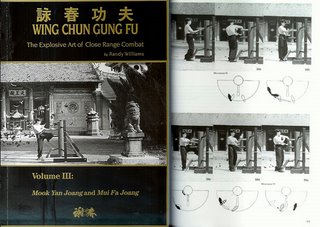This place discusses uses of the Wing Chun Wooden dummy; its non/classical uses, debate, share tips and everything dummy related. (I have diversified however, when I see other things that are of value).
Thursday, December 07, 2006
Elbows, Knees And Kicks And Confidence Stuff.
One bad habit I had that was revived was trying to deal with low kicks with my hands and arms. This is a really hard habit to break. I thought I had broken it but its come back.
I had a think and I believe its the dummy form that encourages this. When moving across the dummy, there are double garn-sau to kwan sau transitions. The double garn saus must be in there affecting me. I need to erase this but may have to drop the double garn saus [these are pictured in the DVD cases in posts below - it must be dramatic or something].
Why doesn't the Yip-Man lineage dummy form include knees or leg blocks to kicks ? Only the one performed by Randy Williams includes some knee and leg defenses. I must transplant some of these into what I do and / or drill them. (He has a bong gerk type move to the lower dummy arms too - if I recall).
Also whats not in the 116 movements are elbows. Why arn't these in the form ? You don't have to strike the dummy but can simulate. Space could be made for this by removing the tok sau moves that are over-represented, (be honest do you envisage using double-tok sau in a confrontation ?!)
Is this heresy ? Does it matter if you mess with tradition ?
Also while I am at it all my Wing Chun stuff goes out my head when in Vale Tudo. I would have to consciously tell my self 'I know some wing chun shapes' to use them. This is funny because when not doing Vale Tudo - say if I am frightened by something then wing chun shapes emerge. I wonder why this is.
Actually one wooden dummy move does look like a Vale tudo move. The circling hands of the 116 form (kau saus ?!) do look like pummeling for under-hooks in vertical grappling.
I go through ups and downs in faith in my dummy / WC skills. I don't think I would last that long in a traditional WC method vs Vale Tudo style approach. A skilled player can close the range so fast they are chest to chest straight from boxing range - with no in-between it seems. And then they dive to a lower level like a U-boat. Some fast footwork must be needed to counter this to keep the range or something.
Thursday, November 23, 2006
Same But Different ?


I am interested in the wooden dummy for this blog but this is a general issue of Wing Chun that goes beyond the dummy. It's the disputes within Wing Chun over how one way is 'the' way and everything else is modified.
I had a good replay to a question on the AWCAOnline blog that you should be looking at - if your not already. I asked Phil Bradley its proprietor why footwork is an issue in dividing Wing Chun schools.
see here :
http://awcaonline.com/blog/?p=69#comments
His reply reminded me of the issue of relativism in the philosophy of Science and Thomas Kuhn's issue of Paradigms. This was derived from astronomy, but the point here is how different interpretations can be seen to be true, relative to the 'framework' they are applied with.
Phil made the point that different moves 'work' within different frameworks of footwork, [paradigms if you like]. The moves are 'true' relative to the way they are trained in the specific location / school that spawned them. Outside of this they may not be 'true', given a different 'paradigm'. IE a different school cannot utilizes their moves as their foundation is different and not optimized for those moves.
An issue here is they are same Wing Chun family but a slight difference in a variable yields new consequences. The impact this has on the 'scientific' street fighting is a cultural one - politics occurs around the 'truth'.
I am including 2 pictures here of 2 airplanes. They belong the same family of planes but they differ structurally but were capable of performing a 'fighting' function:
Here is a conventional design.
Spitfire:


This is the Blohm and Voss 141. It was a viable plane design:
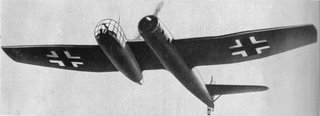
So what's the point. They both 'work' but are different too. (Check the link on youtube if you dont believe the above plane flew: http://www.youtube.com/watch?v=9JAH6CiOu0w) .
Which is the 'true' plane ? Which disobeys the laws of flight ?
Friday, November 17, 2006
Bruce Lee and the Dummy
Here is an article from kungfiMagazine.com
I include this because it enlightens us to alternative uses of the dummy and some innovative ways to use it and train. This is thinking outside the box stuff and if you're not used to this the nit will cause discomfort or fascination.
- The dummy 'form' is split up into 'sets' of moves 1 to 12, that can be juggled
- The juggling of the 'sets' allows for more free-play of the moves vs application in a linear way. E.g. start at set 7 and then move to 2, rather than work from set 1 to 7.
- The dummy can be used like a punch bag to practice angles, leverage, movement, accuracy
I would love to have seen a film of Bruce Lee on the Dummy it would be really enlightening indeed.
There are some videos - very rare - of the Bruce Lee Jun Fan sets - 10 sets of movements that look like modified Wing Chun. And then another 10 Jeet Kune Do sets that have moved away from Wing Chun-style and are more dynamic (by this I mean less upright structure and use of space to zone in and out and around the dummy is more varied).
I wonder why Inosanto hasn't published material on these sets and their use or a video on them ?
(I will review the tapes I have on these in another post- the are by a Spanish practitioner)
http://ezine.kungfumagazine.com/magazine/article.php?article=92
Worth reading.
Wednesday, November 15, 2006
research ...
He didnt agree with the way the criticisms were formed but there were some grains of truth he felt.
I re-looked myself and yes its not perfect: he does seem to lean in for the butterfuly hands - but I see instructional DVDs 'masters' doing that too - he he isnt alone. He thought too there should be power in the strikes. (I thought the sharp clacks = power ?!). Also power on the dummy may not always be the aim *IF* the user is biasing positional skill - I think - for what thats worth. (This is all open to interpretation).
I re-looked at his feet and he may be on his toes for pivoting.
The point of this isn't the practitioners skill - its the use of the internet to share and understand and provoke *useful* criticism. Between the Martial Artist putting up the digitised video, the comments of the youtube 'community, my questioning and reply, posting to another blog to another head instructor and re-watching a circuit of knowledge is reinforced for me.
In other words some new understanding was given to me. I could try and contact the original martial artist and quiz him - that would too give more learning. Don't know how he'd respond though. maybe he would say - yes - I have modified my approach. Thanks very much. Or he could say we are taught to pivot this way because ... let me show you why in this technique ...
I will say it now I am not that good myself on the dummy. I would get slated if I put a video of myself up on youtube - probably rightfully so in some phases of the moves I do. But its worth noting if you look carefully on instructional tapes etc. you do see inconsistencies by 'masters' in their own forms - ie it can be asymmetric sometimes; some moves omitted on one side not another, ad hoc moves inserted. I don't find this a big deal BUT for those who really want to pick hairs be aware of this there is no such thing as perfection in use of the dummy even when doing prescribed forms.
Sunday, November 12, 2006
An example of the 116 movements
http://youtube.com/watch?v=XX_QTqF1GFQ
When I first heard of Wing Chun in the late 80s and looked through MA magazines, I used to wonder in awe what this would look like and how advanced one must be to reach the dizzy heights of accessing this form. Videos to see it cost about £33 and were above my pocket.
Now, in the next century the digital revolution and growing market for Wing Chun has made this form more accessible to see - and learn. YouTube is a great place. The whole idea of this and the 80s situation I describe are approximating the idea of a 'gift society'.
I liked what this practitioner has done here in his video. Nice clacking noises signify power into the dummy. I believe he has body unity and knows the form. Some of the negative comments he gets shows the bad side of free-speech. he gets slated and there are no comments showing him how else he should do the form specifically if he has got it soooo wrong. (He hasn't and the comments are attention seeking snipes).
The dummy can be interpreted differently within WIng Chun schools as well as between them ! Personal style is relevant too.
Here is Yip Man doing the form:
http://youtube.com/watch?v=1m9cOBOhsS4
He is doing two forms here, Chium Kiu, where the practitioner learns to pivot and learns some kicks (plus other things). These shapes are then also planted onto the Wooden dummy along with moves from the 1st and 3rd forms.
It is said that Yip Man simplified the form from 140 moves to 116 moves - but if this is so why are mainland Chinese forms also adhering to the 116 moves format and not 140 ?
http://youtube.com/watch?v=ZTXA5snEYa8
This is William Chung's contribution to the wooden dummy. He has nice chops to the dummy very fast and smooth. His footwork is staggered at points and marks out his schools difference to Wing Chun over some others.
Monday, October 30, 2006
Training outside ?
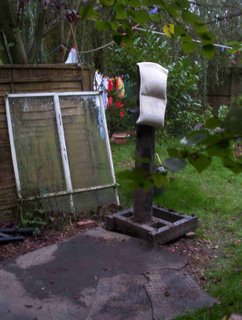
One reason why I bought my plastic Wing Chun dummy was because I have to train outside. It tends to rain outside - especially in Britain. When you train outside the ground gets churned up and the grass vanishes and is replaced by mud.
To get around this I bought a cattle mat / stable mat. This is a thick rubber mat that is about 7 x 4 foot or so. It weighs 7 stone ! I lay this down to train on and have some old car mats to place when I step off the mat. This helps to aid me train when it rains. If I didn't have this it would be a mud bath. Also I would slip all over the place.
Also I include picks of how I add in a sand bag to the dummy. I don't want to nail any bags to the dummy so hang it with plastic taping I got off a parcel. Its strong enough to take the weight of the wall bag [with just 2 sections filled]. Because I used the bag once when it was wet the normal side is splitting and leaks sand when punched so I taped that up and use this zipped side. I don't usually hit the zip so it doesn't matter.

Leg and 2 arms were taken off today as I was just kicking and entering with straight blast.
Tuesday, October 03, 2006
Randy WIllams work on the dummy
The Explosive Art of Close Range Combat
Volume #3 Mook Yan Joang and Mui Fah Joang
by Randy Williams
Review
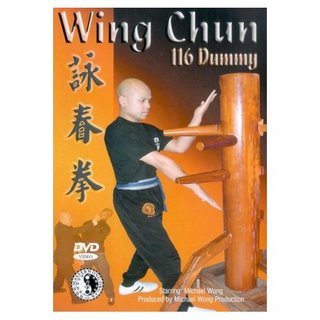
Review of Master Wong’s DVD on the 116 Movements.
I bought the 1st edition of this DVD in 2003 about April and didn’t have a DVD player to watch it until December of that year. Come to that I didn’t have a Wooden Dummy either ! (Actually I still don’t really as I have a plastic Immortal one – but that split’s hairs and we want to move away from all that. (Ok I have wooden arms specially made for it – happy)).
OK the 1st edition is good. Very good. The use of the menus is very good as it supply’s aspects of the form into chunks. Applications too have a menu for themselves too. It’s the best menu system I have seen on any DVD of martial arts. It allows you to get to the part of the form you want.
To learn this form I utilised step motion and drew cartoons of stick men to learn the form. It took me about 5 months to learn the form properly. I would not move on until I knew the part off by heart and had some flow. The learning experience was really exhilarating.
I also cross referenced this form with a disk I got off ebay. This was the Pan Nam disk – which by coincidence was the same style of Wing Chun that Michael Wong’s form was (but he wont go into style issues on the DVD or his www-site for some reason). I then chose aspects I could understand and excluded minor parts I didn’t. For example in the final third there are some finger jabs I didn’t want to use / understand so I modified this.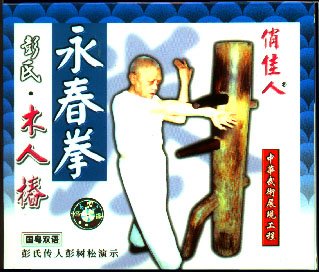
2 years Later there is a second edition of Michael Wong’s disk and I bought that too. Glad I did as its even longer (3 hours) and more verbal explanation. He breaks down some of the moves and explain typical mistakes. There are some useful drills offered too – such as jut gerk type leg sweep. This is something I drill now.
Also you see some teaching going on in the extras menu in the author’s club with question and answer session. I wonder what it would be like to study there for a year.
Sunday, October 01, 2006
Some links
This is a link to someone who got me introduced into the martial ats. He is an original Jeet Kune Do practitioner. There is a rare video tape of him using a wooden dummy in JKD way. This differs from formal Wing Chun becuase the attacks are using moves from other styles and the footkwork doesnt keep the centre line square to the dummy that often.
http://www.awcaonline.com/
This is an interesting place to visit. It has distance learning ideas for Wing Chun and posts videos and commentry. The ideas in this place are thought provoking and has good mission statment to avoid Wing Chun politics [ie the disputes which substyle is 'the best']. I would very much like to see the distance learning program online and live link up to class with feedback potential. The idea is bold.
http://www.youtube.com/watch?v=AWfK6aqWiNU
MMA's contribution and the 'dead patterns debate'
The arguemt posted here in this link is debated elsewhere on the www. It challenges traditional drills and claims they have no function alone - if at all. This implies that much of the drilling material done in many do jos / kwons gyms is not functional.
The counter to this debate is taken up by Mark Denny from The Dog Brothers. He'd argue that drills have a use but you need to know what your looking at when they *are* being applied.
Its a good debate. If you invest time in any form of drilling be aware of this debate and where you think your training does / doesnt stand within this. Its vital to be questioning your learning and practice.
The wooden dummy I think would not be liked by Matt Thornton. Its 'dead' and not alive. My take is its a supplement like a vitamin pill. Its not your dinner its an aid. You can vary the way you train on it to get it more realistic that pure 108 movements style form. Some imagination is needed though. Remember its for those without a training partner.
http://www.ukwingchun.com/Wooden_Dummy.htm
Some useful tips on the dummy are on Steve Sinclair's web site. For example he warns against the implications of having a gap between the floor and the leg of the dummy. This allows the student to avoid the circling movment when moving around the dummy.
The advice for jut gerk (pulling leg or jerking leg ?!) is interesting - stop too deep and you get judo thrown. Step too shallow and you cant get leaverage and you can be sweapt. Sound advice.
Out of interest I have Steve Sincalair's tape Wing chun pure and simple. This is a good tape. What I liked about this was he gives advice on how to condition your hands and shows you how to use a sandbag. He shows you how to rub in dit da jow(hit fall wine) into your knuckles etc. He said Brandy could be a substitute. All good advice. Also I liked the way he gave pros and cons to movemnt and footwork methods. How refreshing. This empowers to the Wing Chun student because they are given choices and freedom to think with in the theoretcial framework of the system. Its not all 'laws' that are relevant in all contexts.
Slightly modified Dummy ?
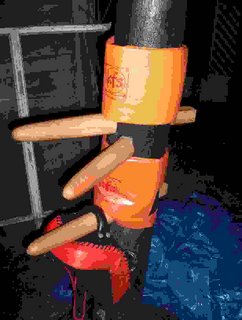 Ok here is another post to this emerging page.
Ok here is another post to this emerging page.What I have done is to show my dummy. This is a plastic Immortal dummy with the leg removed this time to allow access to my Thai pad.
The Thai pad had been squashed up against the mid section to allow knee stikes. If enough pressure is applied it will stay there and keep its inverted 'L' shape. *BUT* dont go mad - it will slip and you will smash your knee cap. Using the straps just remove the 'L' shape and the pad is straigthened out. This means there is no nice space to absorb the 'forward' direction I want from the knee strike into the body not an upward strike into the arm.
The knee strike is really from Thai boxing as it can easily flow out of a wing chun stance or Bi Jong WC/JKD stance. It doesnt matter- it all hurts.
The orange pads are really to stop you being blatently bruised but you cant go flat out on these. Your joints would feel it. Even doubled up those orange pads arnt enough to give flat out strikes. You would need a sandbag for that.
The dummy has the pegs removed from the corner of the base to allow yeild when forward force is applied - I chose this to give some feeback when force was going into the dummy - and save my joints from absorbing all the force. It may be worth putting the wedges back everynow and then to see if your stance can take feedback with out crumbling.
The reason why I remove the leg sometimes is to allow more access to the pad and also copy Joseph Simonet's use. Joseph Simonet's videos on the dummy in 'Extreme Wing Chun vols 1 and 2' and his form tapes - 'Slam Set'. These had a big influence on me as they synthesised Silat with Wing Chun and Kali ideas. More on this later .....
The leg removed simplifes things and you can still be forced to veer off in a 'V' shape due to the arms. I put the leg back when I want to really be forced to veer off to the flanks more blatently / practics sweeps or oblique kicks to the 'knee'. Even without the leg on kciks can be done to the square base or body of the dummy - but these have different qualities
Friday, September 22, 2006
Introductory Aims

The aims of the blog are to discuss the uses of the Wing Chun wooden dummy for fighting arts training. This is to cover both traditional and non-traditional uses of the dummy.
I have been collecting materials about the Wing Chun dummy for about 3 years now. This includes - Videos, DVD, books and looking at www pages and online videos. As Wing Chun has become more widely disseminated in the west so have materials of this training aid and availability of dummy too.
I would hope this place is going to be a repository of ideas and discussion from practitioners; curious by-standers and anyone interested in martial arts per se. I will try to post up picture and video links.
I don't really want to see it degenerate into negative comments like 'this sucks everyone knows Master X is the best - give up'. This type of commentary helps no one. It lacks evidence to support the claims being made and it attention seeking at best. Better would be to think of pros and cons to an issue.
Regards !
